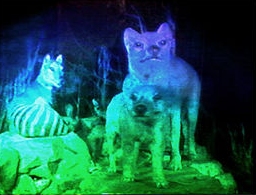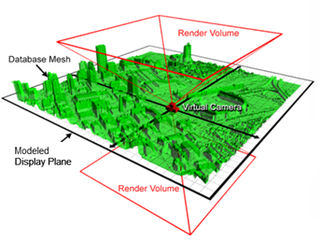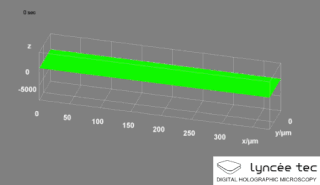Related Research Articles

Holography is a technique that enables a wavefront to be recorded and later re-constructed. Holography is best known as a method of generating real three-dimensional images, but it also has a wide range of other applications. In principle, it is possible to make a hologram for any type of wave.

Stereoscopy is a technique for creating or enhancing the illusion of depth in an image by means of stereopsis for binocular vision. The word stereoscopy derives from Greek στερεός (stereos) 'firm, solid', and σκοπέω (skopeō) 'to look, to see'. Any stereoscopic image is called a stereogram. Originally, stereogram referred to a pair of stereo images which could be viewed using a stereoscope.

A spatial light modulator (SLM) is an optical device that imposes some form of spatially varying modulation on a beam of light. A simple example is an overhead projector transparency. Usually when the term SLM is used, it means that the transparency can be controlled by a computer. In the 1980s, large SLMs were placed on overhead projectors to project computer monitor contents to the screen. Since then, more modern projectors have been developed where the SLM is built inside the projector. These are commonly used in meetings for presentations.

A 3D display is a display device capable of conveying depth to the viewer. Many 3D displays are stereoscopic displays, which produce a basic 3D effect by means of stereopsis, but can cause eye strain and visual fatigue. Newer 3D displays such as holographic and light field displays produce a more realistic 3D effect by combining stereopsis and accurate focal length for the displayed content. Newer 3D displays in this manner cause less visual fatigue than classical stereoscopic displays.
A volumetric display device is a display device that forms a visual representation of an object in three physical dimensions, as opposed to the planar image of traditional screens that simulate depth through a number of different visual effects. One definition offered by pioneers in the field is that volumetric displays create 3D imagery via the emission, scattering, or relaying of illumination from well-defined regions in (x,y,z) space.

EOTECH is an American company that designs, manufactures, and markets electro-optic and night vision products and systems. The company is headquartered in Plymouth, Michigan. They produce holographic weapon sights for small arms that have been adopted by various military and law enforcement agencies as close quarters battle firearm sights.
Holographic data storage is a potential technology in the area of high-capacity data storage. While magnetic and optical data storage devices rely on individual bits being stored as distinct magnetic or optical changes on the surface of the recording medium, holographic data storage records information throughout the volume of the medium and is capable of recording multiple images in the same area utilizing light at different angles.

The rainbow or Benton hologram is a type of hologram invented in 1968 by Dr. Stephen A. Benton at Polaroid Corporation. Rainbow holograms are designed to be viewed under white light illumination, rather than laser light which was required before this. The rainbow holography recording process uses a horizontal slit to eliminate vertical parallax in the output image, greatly reducing spectral blur while preserving three-dimensionality for most observers. A viewer moving up or down in front of a rainbow hologram sees changing spectral colors rather than different vertical perspectives. Because perspective effects are reproduced along one axis only, the subject will appear variously stretched or squashed when the hologram is not viewed at an optimum distance; this distortion may go unnoticed when there is not much depth, but can be severe when the distance of the subject from the plane of the hologram is very substantial. Stereopsis and horizontal motion parallax, two relatively powerful cues to depth, are preserved.
Lloyd Cross is an American physicist and holographer.

Yuri Nikolayevich Denisyuk was a Russian physicist and one of the founders of optical holography in the former Soviet Union. He is known for his great contribution to holography, in particular for the so-called "Denisyuk hologram". He was a full member of the Russian Academy of Sciences, doctor of physical and mathematical sciences, professor (1980).

A hogel is a part of a light-field hologram, in particular a computer-generated one. It is considered a small holographic optical element or HOE and that its total effect to that of a standard hologram only that the resolution is lower and it involves a pixelated structure. An array of these elements form the complete image of a holographic recording, which is typically displayed in 3D free-viewing device.
Computer-generated holography (CGH) is the method of digitally generating holographic interference patterns. A holographic image can be generated e.g., by digitally computing a holographic interference pattern and printing it onto a mask or film for subsequent illumination by suitable coherent light source.

Stephen Anthony Benton was the E. Rudge ('48) and Nancy Allen Professor of Media & Sciences, and the Director for Center for Advanced Visual Studies (CAVS) at Massachusetts Institute of Technology. He was the inventor of the rainbow hologram and a pioneer in medical imaging and fine arts holography. Benton held 14 patents in optical physics and photography, and taught media arts and sciences at MIT.

Australian Holographics was a laboratory based in Adelaide, South Australia established in 1989 with the specific objective to produce high quality large format holograms. After two years of research and development the company began commercial operations in 1991. The laboratory eventually shut down in 1998.

Nicholas (Nick) John Phillips was an English physicist, notable for the development of photochemical processing techniques for the colour hologram. Holograms typically used to have low signal-to-noise ratios, and Phillips is credited as the pioneer of silver halide holographic processing techniques for producing high-quality reflection holograms.

Zebra Imaging was a company that developed 3D digital holographic images, hologram imagers and interactive 3D displays for government and commercial uses. The company offers digital holograms that are autostereoscopic, full-parallax and in monochrome or full-color. They have also developed a 3D Dynamic Display, which is capable of rendering holograms in real time; design work with 3D programs such as SketchUp and 123D Catch can be viewed on a holographic display while they are actively being edited.

Digital holographic microscopy (DHM) is digital holography applied to microscopy. Digital holographic microscopy distinguishes itself from other microscopy methods by not recording the projected image of the object. Instead, the light wave front information originating from the object is digitally recorded as a hologram, from which a computer calculates the object image by using a numerical reconstruction algorithm. The image forming lens in traditional microscopy is thus replaced by a computer algorithm. Other closely related microscopy methods to digital holographic microscopy are interferometric microscopy, optical coherence tomography and diffraction phase microscopy. Common to all methods is the use of a reference wave front to obtain amplitude (intensity) and phase information. The information is recorded on a digital image sensor or by a photodetector from which an image of the object is created (reconstructed) by a computer. In traditional microscopy, which do not use a reference wave front, only intensity information is recorded and essential information about the object is lost.
Specular holography is a technique for making three dimensional imagery by controlling the motion of specular glints on a two-dimensional surface. The image is made of many specularities and has the appearance of a 3D surface-stippling made of dots of light. Unlike conventional wavefront holograms, specular holograms do not depend on wave optics, photographic media, or lasers.

A holographic weapon sight or holographic diffraction sight is a non-magnifying gunsight that allows the user to look through a glass optical window and see a holographic reticle image superimposed at a distance on the field of view. The hologram of the reticle is built into the window and is illuminated by a laser diode.
Optical holography is a technique which enables an optical wavefront to be recorded and later re-constructed. Holography is best known as a method of generating three-dimensional images but it also has a wide range of other applications.
References
- 1 2 3 4 5 6 Sergey, Zharkiy. "History of the holography". www.holography.ru. Retrieved 2016-02-02.
- ↑ "DARPA's Urban Photonic Sandtable Display enables 3D battlefield planning without goofy glasses". Engadget. Retrieved 2022-08-31.
- ↑ Hologram touch UI in Lykan Hypersport supercar , retrieved 2022-08-31
- ↑ "The Progression of Holography into Business– An interview with Dr. V. Michael Bove, Jr. MIT Media Lab". www1.huawei.com. Retrieved 2016-02-12.
- ↑ Staff. "5 Amazing Holographic Displays, Technologies That Actually Exist Now - TechEBlog". www.techeblog.com. Retrieved 2016-02-02.
- ↑ "3-D TV? How about Holographic TV?". MIT Media Lab. Retrieved 2022-12-15.
- ↑ "Japanese scientists create touchable holograms". Reuters. 2015-11-30. Retrieved 2016-02-02.
- ↑ "Touchable 3D holograms in daylight now possible using superfast femtosecond lasers". International Business Times UK. Retrieved 2016-02-12.
- ↑ Mitsubishi is developing a hologram-like 'Aerial Display'